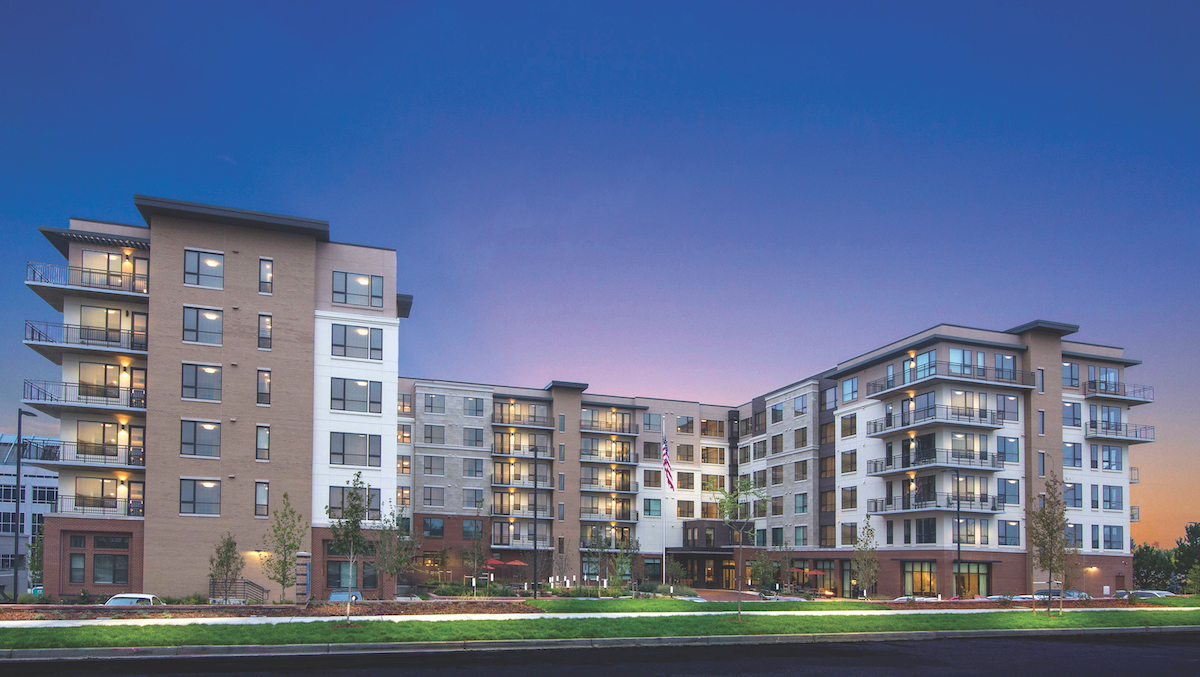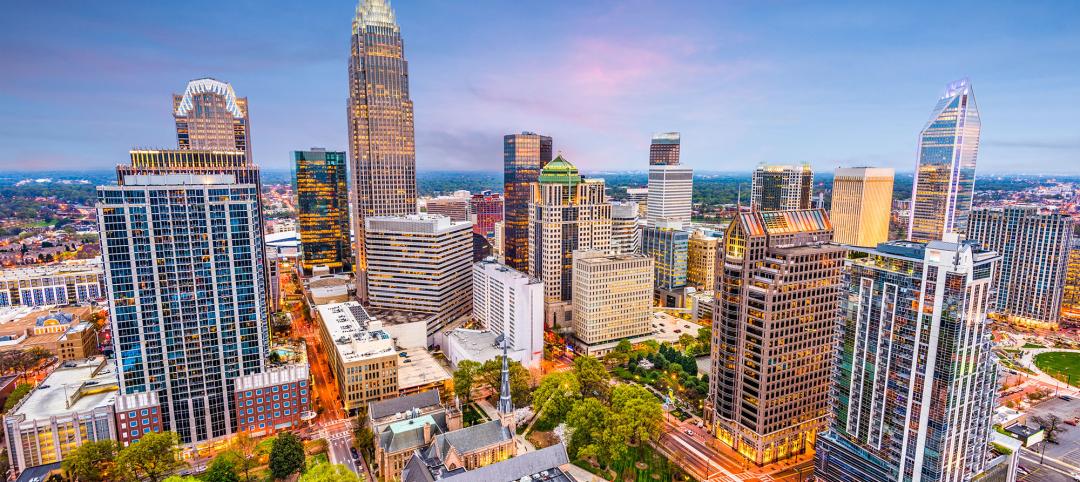Enter The Carillon at Belleview Station from the streets of Denver’s bustling Tech Center District, and your first impression is of a residence that is contemporary, sleek, and upscale. The sliding glass doors open to a quartz-and-wood reception desk with a staggered row of pendant lights overhead and a striking abstract painting on the wall. A floor-to-ceiling stone-look porcelain tile wall is accented with a greenery-filled window that peers into the expansive lobby.
The colors are fun. The finishes are fresh. The feel is energized urban living. This is senior living with style.
“It’s beautiful, but the beauty is very functional, very modern,” said Angie Erickson, General Manager of the 173,000-sf complex, which has 139 independent and assisted-living suites and 24 memory care suites. “I’ve been in the residential industry 17 years, and this is the most conducive environment I’ve ever worked in.”
“We’re always trying to change the perception of what senior living is,” said Shauna Revo, Associate and Project Design Manager at StudioSIX5, the interior design firm for The Carillon at Belleview Station.
Communities for the 55+ set are changing, said B. Dean Maddalena, AIA, NCARB, IIDA, ASID, NEWH, President of Austin, Texas–based StudioSIX5, which he founded in 2003 and which specializes in interior design for senior living. “Senior communities used to be about seclusion and security,” he said. “Now, seniors want to be in the city, integrating with the surrounding community. It’s a huge, positive shift.”
StudioSIX5 has completed more than 400 senior living projects in 34 states and the District of Columbia, from active adult communities to memory care centers. The firm recently compiled 11 trends that Maddalena believes will guide design decisions in senior living communities.
1. Senior living residential style will be more eclectic. Seniors are ready for variety in furnishings and finishes, more layering of patterns, said Maddalena. “By this time in their lives, people have traveled, they’ve been everywhere,” he said. “They realize that one room doesn’t have to be all Chippendale. It can be a mix of styles.”
2. Senior living communities are taking advantage of open floor plans. “It used to be that every activity needed its own room, which sat empty most of the day,” said Maddalena. That’s changed. The movie room can also serve as the chapel, the lecture hall, a meeting room, or a training room. “We don’t really have libraries in our senior communities anymore,” he said. “It’s more like a Starbucks with magazines.”
The Carillon’s dining room is outfitted with sliding doors that open up access to the private family dining room, the activity room, and the theater. “It’s phenomenal when you have events,” said Erickson. “You’re not trying to shove people into little rooms.”
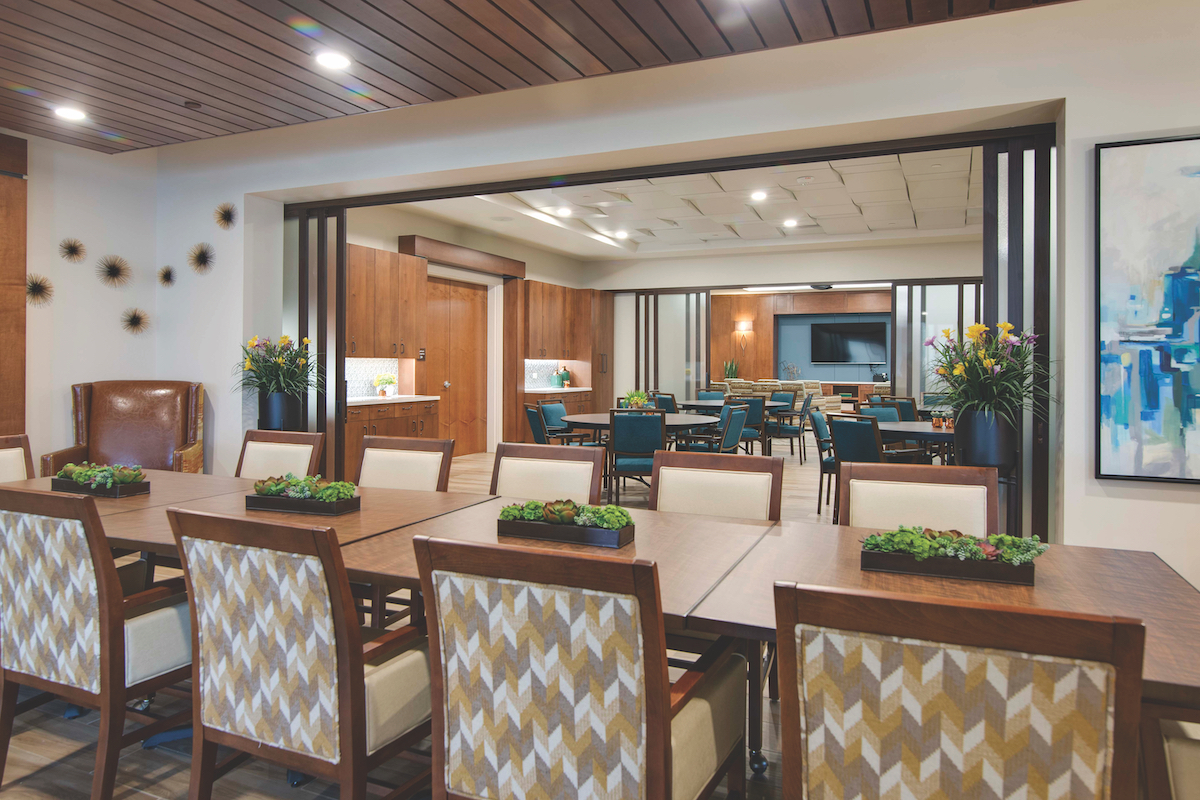
#2 Open Floor Plan. Photo: Michael Lowry Photography
3. Crisp jewel tones will gain in popularity for paint, furnishings, and accessories. Jewel tones and saturated colors permeate StudioSIX5’s communities, from upholstered chairs and draperies to decorative pillows and curated art.
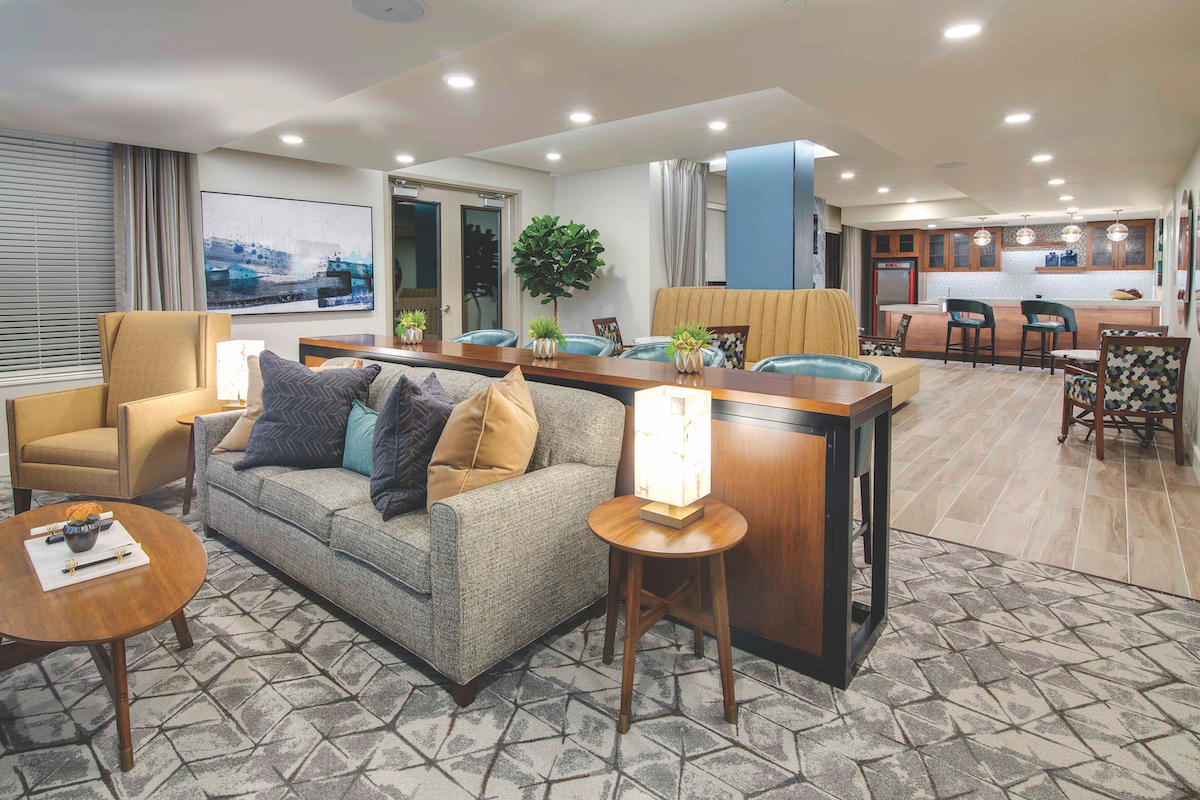
#3 Jewel tones and saturated colors. Photo: Michael Lowry Photography
4. Cool-toned grays and silver accents will shift to warmer neutrals and metallics in finish selections. The once ubiquitous gray is moving toward a “beige/gray in-between,” Maddalena said. He and his team test how colors relate to seniors’ changing visual capabilities. “We wear yellow glasses to simulate how the changes in seniors’ corneas affect how they see colors,” he said. “Gray doesn’t look much like anything. When you introduce beige, it mellows everything out for the more saturated colors.”
Metallic finishes fit well with clean, contemporary design; they add heightened luxury and an organic quality. Metallics are showing up in lighting fixtures, consoles, side tables, and upholstered seating areas.
5. Digitally printed materials will bring heightened personalization to senior living design. “We can print photos on laminate and make custom countertops,” said Maddalena. The firm has printed a resident’s face on a pillow and presented it as a gift. They’ve photo-reproduced the Chicago skyline and upholstered it on a banquette, and used the same technique to make a carpet that looks like grass.
6. Lighter wood tones are gaining popularity in furnishings and millwork. “The pendulum is swinging away from dark, dark woods,” said Maddalena. Now it’s more mid-tones and browns—natural walnut, birch, ash, and natural rift-cut oak—for cabinetry millwork in reception desks, dining areas, and individual apartment kitchens.
7. Services and amenities should integrate 55+ residents with the community. As active seniors looking for independent and assisted living gravitate to urban centers to take advantage of restaurants, shops, entertainment, and healthcare, there’s a growing emphasis on providing amenities that draw in the public to help residents feel engaged with their neighbors. The Carillon’s hair salon is open to—and popular with—the public, and its sixth-floor sky lounge can be rented out for functions.
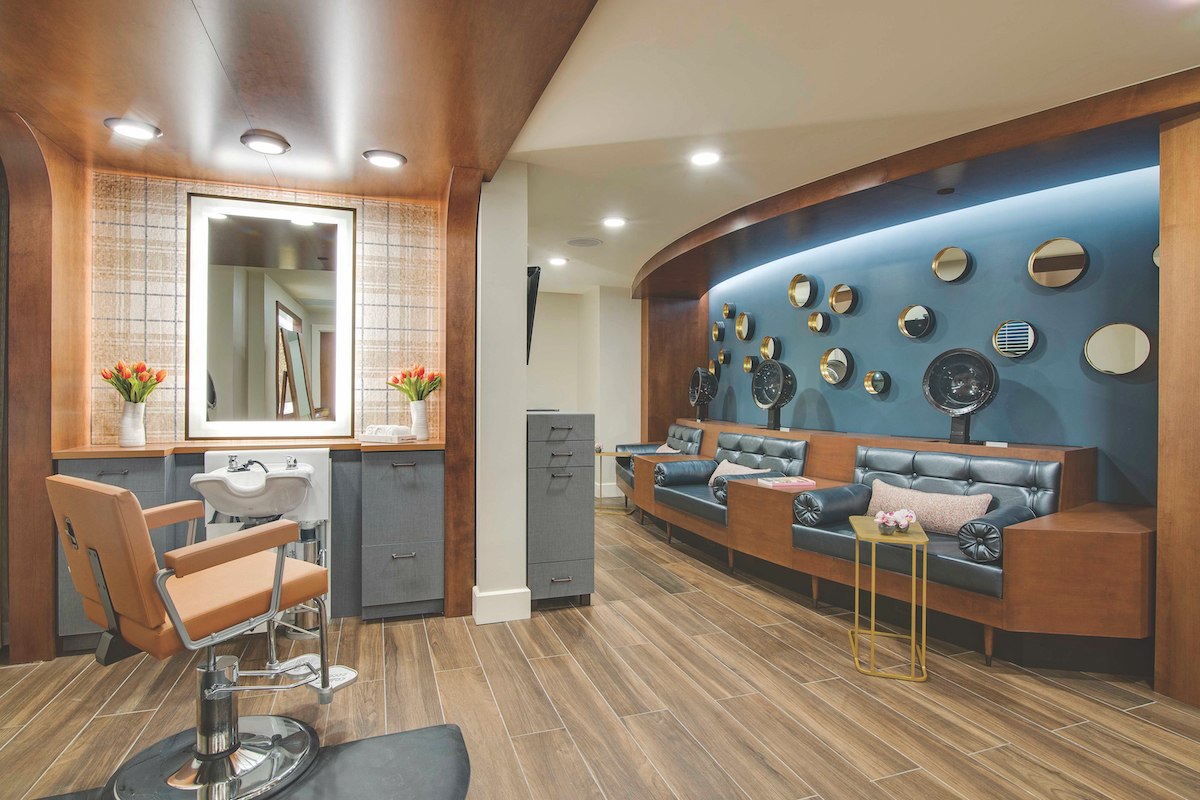
#7 Services and amenities. Photo: Michael Lowry Photography
8. Senior living communities will create more outdoor amenity “destinations.” Outdoor spaces should be an integral part of activity programming, even in hot climates. An outdoor theater with lawn chairs, where residents can watch a movie and have dinner and cocktails; a greenhouse with a gardening club; or dining spaces where residents can cook for themselves and host parties—spaces like these enliven the 55+ residential experience.
“We work on a cooking function, a lounging function, a fire pit, and a pool,” said Claire Richards, a StudioSIX5 Senior Associate who led the design team for the Overture Barrett, a 55+ community in Kennesaw, Ga. “It’s about making that another living space.” Pergolas, fountains, large-screen TVs, grills, and green lawns for yoga, bocce, or cornhole are also options. “We usually do a little pet walk along the exterior,” said Richards.
Outdoor activities should be sited so that residents can easily see from one to another. “It was once popular to spread the amenity spaces throughout the community, but we learned that out of sight was out of mind,” Maddalena said. Now, it’s important for residents to be able to see what else is going on as they engage in an activity.
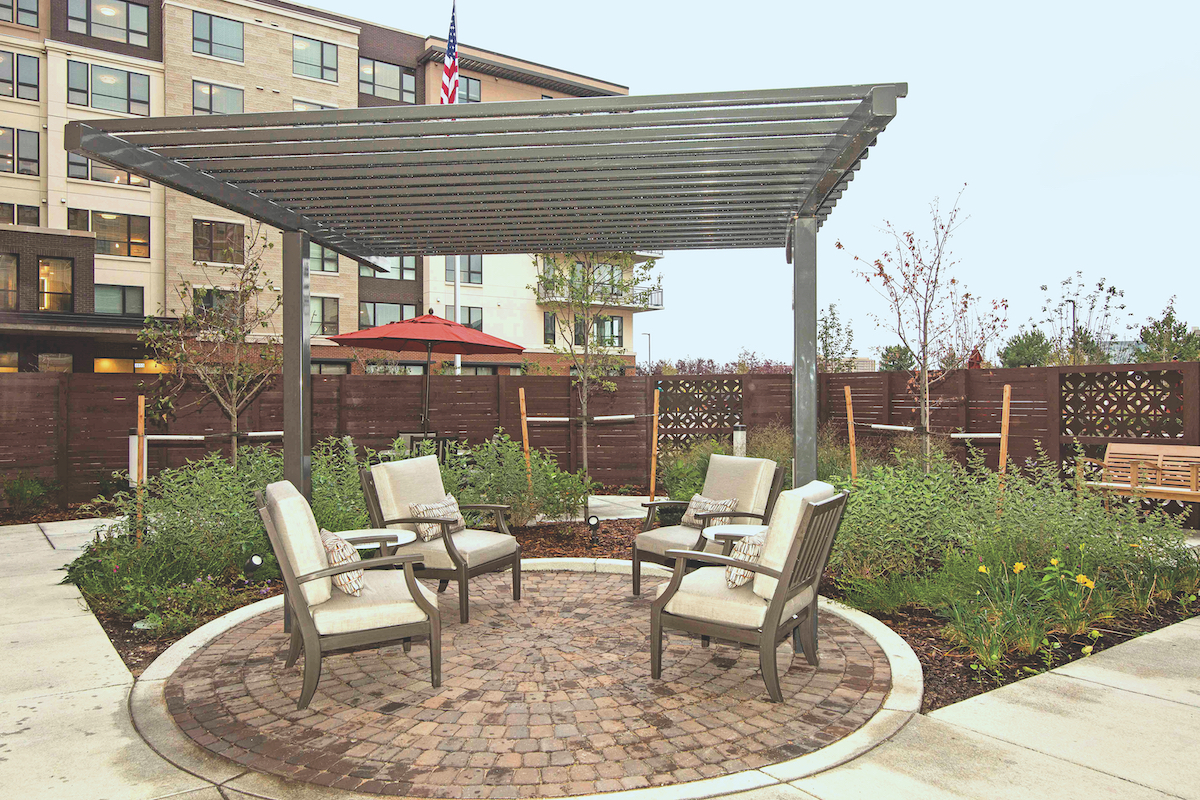
#8 Outdoor amenity destinations. Photo: Michael Lowry Photography
9. LVT and porcelain are becoming materials of choice. As recently as a few years ago, Maddalena said, StudioSIX5 would not even consider specifying wood-print luxury vinyl tile or porcelain tile: the quality just wasn’t up to the standards of the firm—or the 55+ end users. Now, LVT and porcelain are accepted market-wide, and are StudioSIX5’s go-to products for their durability, style, and affordability.
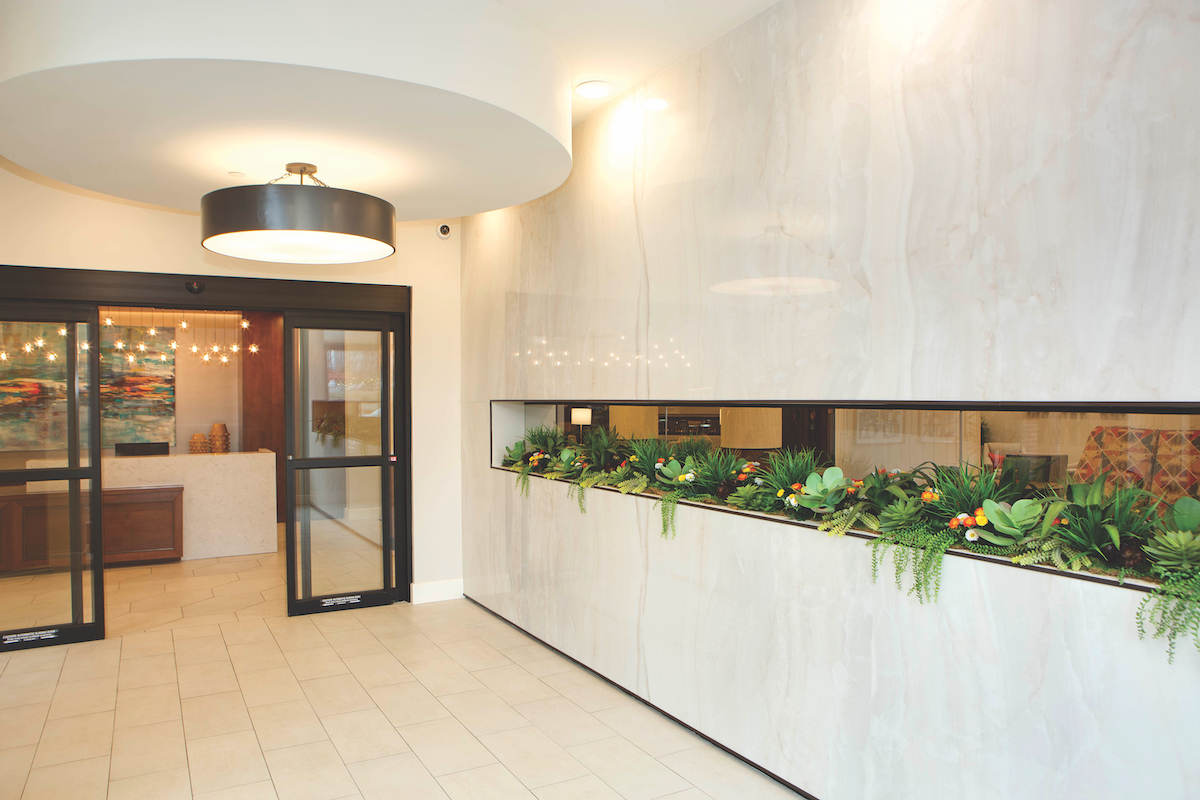
#9 LVT and porcelain tile. Photo: Michael Lowry Photography
10. Bars with self-serve point-of-service systems will rise in popularity. These systems allow residents to grab a snack or a drink, charge it on their keycard, and get a bill at the end of the month. Senior communities will still have happy hours where employees will serve the drinks, Maddalena said, but self-service is becoming more of an option. Staffing is expensive, he said, and “you want your staff focused on providing personal attention where it’s really needed.”
11. Employee amenities will need upgrading. A poorly furnished white room with vinyl floors, stuck in the back by the loading dock—welcome to the employee lounge of yesteryear. In today’s tight labor market, finding and keeping good staff is difficult, so StudioSIX5 is creating colorful, enhanced employee spaces with more care in the design and the choice of materials.
“Whether it’s a lounge with beanbag seating and a pool table, or allowing employees to use the fitness equipment, or providing child care, they want to feel like they’re cared about,” Maddalena said.
Build on these concepts for your 55+ projects, and you’ll be creating senior living communities that anyone would love to call home.
Related Stories
Sustainability | Feb 7, 2024
9 states pledge to accelerate transition to clean residential buildings
States from coast to coast have signed a joint agreement to accelerate the transition to pollution-free residential buildings by significantly expanding heat pump sales to meet heating, cooling, and water heating demand in coming years.
Multifamily Housing | Feb 5, 2024
Wood Partners transfers all property management operations to Greystar
Greystar and Wood have entered into a long-term agreement whereby Greystar will serve as property manager for all current and future Wood developed and owned assets.
Industry Research | Jan 31, 2024
ASID identifies 11 design trends coming in 2024
The Trends Outlook Report by the American Society of Interior Designers (ASID) is the first of a three-part outlook series on interior design. This design trends report demonstrates the importance of connection and authenticity.
Mixed-Use | Jan 29, 2024
12 U.S. markets where entertainment districts are under consideration or construction
The Pomp, a 223-acre district located 10 miles north of Fort Lauderdale, Fla., and The Armory, a 225,000-sf dining and entertainment venue on six acres in St Louis, are among the top entertainment districts in the works across the U.S.
Sponsored | BD+C University Course | Jan 17, 2024
Waterproofing deep foundations for new construction
This continuing education course, by Walter P Moore's Amos Chan, P.E., BECxP, CxA+BE, covers design considerations for below-grade waterproofing for new construction, the types of below-grade systems available, and specific concerns associated with waterproofing deep foundations.
Multifamily Housing | Jan 15, 2024
Multifamily rent growth rate unchanged at 0.3%
The National Multifamily Report by Yardi Matrix highlights the highs and lows of the multifamily market in 2023. Despite strong demand, rent growth remained unchanged at 0.3 percent.
Adaptive Reuse | Jan 12, 2024
Office-to-residential conversions put pressure on curbside management and parking
With many office and commercial buildings being converted to residential use, two important issues—curbside management and parking—are sometimes not given their due attention. Cities need to assess how vehicle storage, bike and bus lanes, and drop-off zones in front of buildings may need to change because of office-to-residential conversions.
MFPRO+ News | Jan 12, 2024
Detroit may tax land more than buildings to spur development of vacant sites
The City of Detroit is considering a revamp of how it taxes property to encourage development of more vacant lots. The land-value tax has rarely been tried in the U.S., but versions of it have been adopted in many other countries.
MFPRO+ News | Jan 12, 2024
As demand rises for EV chargers at multifamily housing properties, options and incentives multiply
As electric vehicle sales continue to increase, more renters are looking for apartments that offer charging options.
Sustainability | Jan 10, 2024
New passive house partnership allows lower cost financing for developers
The new partnership between PACE Equity and Phius allows commercial passive house projects to be automatically eligible for CIRRUS Low Carbon financing.


